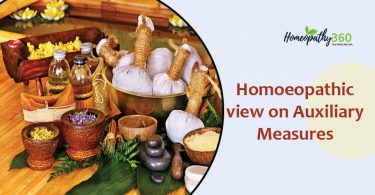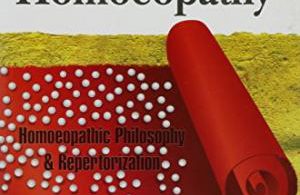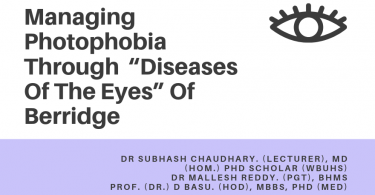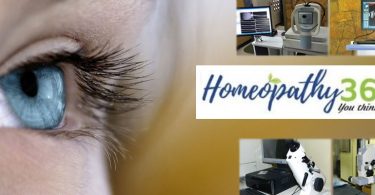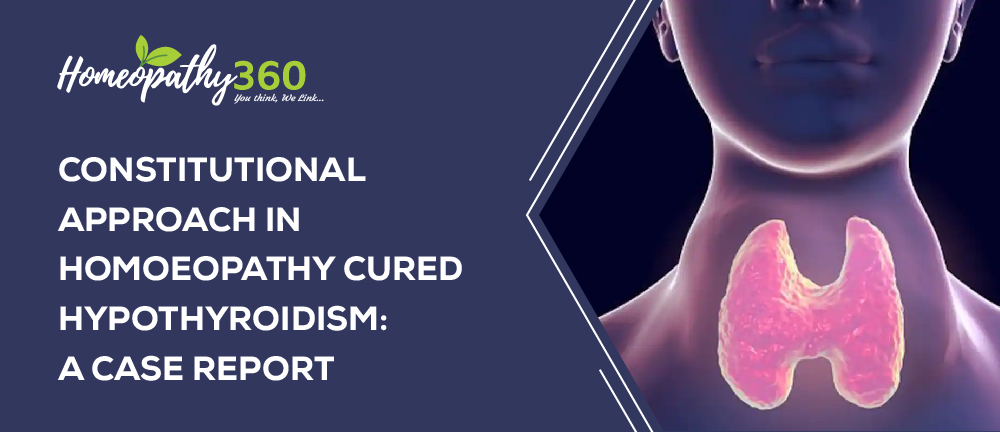
Abstract: Hypothyroidism is a condition which disturbs a person’s harmonious life with weight gain, menstrual irregularities and mood swings. Many patients bear with them, the burden of taking hormonal treatment throughout their lifetime. The carefully selected homoeopathic constitutional medicines can bring about a cure in these sufferers within a short period of time. The following is the case of a 34 year old woman who was freed of her problems of hypothyroidism with homoeopathic constitutional medicines alone.
Abbreviations: TSH – thyroid stimulating hormone, T3 – tri-iodothyronine, T4 – tetra-iodothyronine, FTI – free thyroxine index.
Introduction: Inadequate synthesis of thyroid hormones resulting in its insufficient release for bodily needs is called hypothyroidism.(1) In places where there is no iodine deficiency, autoimmune thyroid disease called Hashimoto’s thyroiditis is the most common cause of hypothyroidism whereas worldwide, iodine deficiency is in the forefront.(2)
The other causes of hypothyroidism include thyroidectomy or radiation therapy in the treatment of overactive thyroid or cancer of thyroid, some medications used in cancer and depression and overmedication in hyperthyroidism or hypothyroidism can also result from disorder of pituitary or hypothalamus, which is called central hypothyroidism.(3)
Primary hypothyroidism can be classified into chronic autoimmune thyroiditis, postpartum thyroiditis, sub-acute granulomatous thyroiditis, drug induced hypothyroidism and iatrogenic hypothyroidism.
The clinical features of hypothyroidism include unexplained fatigue, bradycardia, excessive gain in weight, slowness in movement and speech, lack of appetite, cold intolerance, dryness of skin, excessive loss of hair, sleepiness, locomotor pain and weakness, pitting oedema of lower limbs, hyporeflexia, depression, mental impairment, memory and concentration problems, constipation, disturbances in menstrual cycles, infertility, paraesthesia, decreased vision and hearing and fullness in throat and hoarseness due to the enlarged gland.(2)
Complications of untreated or maltreated hypothyroidism include risk for cardiovascular disease due to the increased levels of cholesterol, goitre, pregnancy complications like pre-eclampsia, fluid retention, anaemia, postpartum haemorrhage, premature birth, miscarriage, myxoedema coma leading to confusion, hypothermia and drowsiness.(4)
It is a major risk factor in fertility and pregnancy. Hypothyroidism accounts for 53.7% of infertility cases. (5) Maltreated hypothyroidism often leads to impaired intellectual, cognitive and neural functions in the newborn. Attention deficit and hyperactive disorders are also not uncommon in children born to hypothyroid mothers.(6)
TSH assays are used as the most sensitive tool for screening primary hypothyroidism. If the TSH level is high, the free thyroxin (T4) or the free thyroxin index level should be evaluated, which is a surrogate of the free hormone level. Routine measurement of tri-iodothyronine(T3) is not indicated. In hypothyroid patients, there will be elevated TSH with decreased T4 or FTI or elevated TSH with normal free T4 or FTI is considered as mild or subclinical hypothyroidism.(2)
Individualized homoeopathic constitutional approach in a case of hypothyroidism is seen to be very effective for its cure, that is disappearance of the symptoms as well as reestablishment of the normal hormonal levels, limiting the chances of recurrence.
Chambers Dictionary defines constitution as the natural condition of the body and mind; disposition. The importance of constitution while treating chronic diseases is mentioned in Aph:5 of Organon of Medicine:
“Useful to the physician in assisting him to cure are the particulars of the most probable exciting cause of the acute disease, as also the most significant points in the whole history of the chronic disease, to enable him to discover its fundamental cause, which is generally due to a chronic miasm. In these investigations, the ascertainable physical constitution of the patient (especially when the disease is chronic),his moral and intellectual character, his occupation, mode of living and habits, his social and domestic relations, his age, sexual function, etc. are to be taken into consideration.”(7)
The concept of constitutional treatment was also advocated by Hippocrates and Paracelsus.(8) and was also used in Chinese medicine.
It is not infrequent that many have to depend on thyroidectomy for an enlarged gland with complications. According to the pioneer of Homoeopathy Dr H A Roberts,
“In removing the tonsils, the teeth or other organs by surgical operation we are dealing with the end product and not with the vital energy. We are cutting off the manifestation of disease and are doing nothing to set in order the vital energy or to prevent further disease manifestations. These diseased conditions have developed as an expression of the inward turmoil and distress under which the whole individual suffers.”(9)
Case report
A woman aged 34 years presented with the symptoms of weakness, wandering type of pain in almost all her joints and lack of appetite, on 16/6/2015. She had been suffering from these complaints for the last 3 months. She was obese for her short height. She was well dressed and had a neat look. The anterior part of her neck showed a swelling. She looked depressed and lacked energy. She had been under hormonal treatment, but discontinued the treatment after a few days of starting the medication and opted homoeopathic treatment.
Mental generals
Slightest criticism from anyone made her unhappy. She was very affectionate.
Physical generals
She had a lack of appetite, thirst was normal. Her urine was normal and she was having constipation occasionally. Reaction to heat and cold: Could not bear hot weather, but she preferred warm bathing. She preferred fanning only when it was too hot and she had an aversion to covering.
She had too short menses lasting only for one to three days. No other abnormalities were detected.
Physical examination
On examination, her pulse rate was 62/minute, respiratory rate-16/minute, blood pressure was 110/70 mm of mercury and she had a normal temperature.
Examination of the neck revealed a uniform enlargement of the thyroid gland. It showed free upward movement on swallowing. No visibly dilated veins were detected on the anterior part of the thorax. Pemberton’s sign was negative.
On palpation, the margins of the gland were well defined. No nodules were detected. The gland was uniformly enlarged. Cervical lymph nodes were not found to be palpable.
No bruit was heard on auscultation. Neck circumference was 34.5 cm.
Laboratory investigations
Thyroid function test revealed a TSH value of 15.39 µIU/ml and T4 of 8.2µg/dl

Diagnosis
Hypothyroidism with simple diffuse parenchymatous goitre.[Y1] (10)
Symptoms considered for selection of remedy
Common symptoms Uncommon symptoms
| Wandering type of pain+ | Sensitiveness to criticism++ |
| Too short menses_+ | Affectionate+ |
| Hypothyroidism+ | |
| Desires spices++ | |
| Desires bread and butter+ | |
| Goitre+ |
Miasmatic analysis (11)
| Symptom | Miasm |
| Wandering type of pain | Psora,sycosis |
| Too short menses | Psora,sycosis |
| Sensitiveness to criticism | Psora |
| Affectionate | Psora |
| Hypothyroidism | Psora |
| Desires spices | Psora |
| Desires bread and butter | Psora |
| Goitre |
| SL No: | Symptoms | Intensity | Miasm | |
| Common symptoms | 1. | Wandering type of pain | + | Psora,sycosis |
| 2. | Too short menses_ | + | Psora,sycosis | |
| Uncommon symptoms | 3. | Sensitiveness to criticism | ++ | Psora |
| 4. | Affectionate | + | Psora | |
| 5. | Hypothyroidism | + | Psora | |
| 6. | Desires spices | ++ | Psora | |
| 7. | Desires bread and butter | + | Psora | |
| 8. | Goitre | + | Sycosis |
Repertorial chart (12)

Prescription
Based on the totality of symptoms, a dose of Natrum muriaticum 200 [Y2] was prescribed. The 200th potency was selected because the patient looked young, intelligent and healthy. But for the symptoms of hypothyroidism, she had no other health problems. She had not taken any other modes of treatment. As the condition is a natural dynamic disease, it is curable. All these factors led to the selection of a moderate potency. (11)
Justification for the remedy and remedy differentiation
RADAR 10.0(Synthesis repertory) was used in repertorising the case. (12) Natrum muriaticum covered all the mental, physical, general and particular symptoms of the patient and served as the constitutional remedy. The patient has the emotional sensitivity of Natrum muriaticum. The other remedies following Natrum muriaticum are Sepia, Sulphur and Nux vomica. Sepia is thermally chilly, but the patient is hot. The patient is more womanly than Sepia and notas extroverted as a Sulphur. Sulphur patients have vitiated affection and are selfish. This patient is very affectionate. The patient was neat and well-dressed unlike Sulphur. Nux vomica patients are chilly and are defensive when criticized. This patient is sad when criticised.(13)
Follow up
| DATE | SYMPTOMS | PRESCRIPTION |
| 16/6/2015 | Depressed moodWeaknessPain in all jointsSwelling of anterior aspect of neck | Natrum muriaticum 200/1 dose |
| 30/6/2015 | Depressed mood persistsWeakness betterPain persistsAppetite betterSwelling persists | Natrum muriaticum 200/1 dose |
| 17/7/2015 | Mood betterNo weaknessPain only in lower limbsSwelling persists | Placebo |
| 31/7/2015 | Pain in lower limbs persistsGood appetiteSwelling persists | Natrum muriaticum 200/1 dose |
| 15/8/2015 | Pain in knees<walkingNeck circumference:33 cm | Placebo |
| 1/9/2015 | Pain in knees better | Placebo |
| 18/9/2015 | Pain in knees as such | Natrum muriaticum 200/1 dose |
| 3/10/2015 | Complaint as such | Natrum muriaticum 1M[Y3] /1 dose(The case had come to a standstill and on further case taking, no additional findings were seen and as the previous potency had exhausted its action, a higher potency was selected)(9) |
| 16/10/2015 | Complaint better | Placebo |
| 30/10/2015 | Neck circumference:32.8 cm | Placebo for 1 month |
| 1/12/2015 | Neck circumference:32 cm | Placebo for 1 month |
Thyroid function test was done on 5/2/2016 which revealed TSH as 2.74µIU/ml and T4 as 7.53µg/dl.

Follow up
The patient discontinued the treatment once the thyroid function test became normal and did not take any medication thereafter. On 13/3/2018, another thyroid function test was done on patient’s own will which showed TSH to be 1.42µIU/ml. This shows that there is no recurrence of the condition which had got cured with the constitutional remedy.

Conclusion
The above case of hypothyroidism treated with individualised homoeopathic constitutional medicine alone, without the use of any tinctures or biochemic medicines shows us that hypothyroidism is curable without the fear of recurrence.
REFERENCES
- Das KKV; Textbook of Medicine; Hypothyroidism;4th ed; New Delhi; Jaypee brothers Medical publishers;2002;P497
- Orlander PR;Hypothyroidism;Available from:https://emedicine.medscape.com
- Underactive thyroid:Overview;Available from:https://www.ncbi.nlm.nih.gov>books
- Underactive thyroid-complications;https://www.nhs.uk>conditions>complications
- Priya DM,Akhtar N,Ahmad J;Prevalence of hypothyroidism in infertile women and evaluation of response of treatment for hypothyroidism on infertility;Indian J Endocr Metab;2015;19:504-506
- Ghassabian A,Bongers-Schokking JJ,de Rijke YB,et al;Maternal thyroid autoimmunity during pregnancy and the risk of attention deficit/hyperactivity problems in children;The generation R study;Thyroid;2012;22(2):178-186
- Hahnemann S; Organon of Medicine;5th ed; New Delhi; B. Jain Publishers;2011;P31-32
- Constitution and constitutional approaches in Homoeopathy;National Health Portal;Available from:https://www.nhp.gov.in
- Roberts. HA; The Principles and art of Cure by Homoeopathy; Low priced ed; New Delhi; B. Jain Publishers;2002;p 144,145,161
- Das S;Examination ot the Thyroid gland;A manual on clinical surgery;5th ed;Calcutta;Dr.S.Das;2002;p294
- Close S;The genius of homoeopathy;Low priced edn;New Delhi;B Jain publishers;2002;p 194-195
- RADAR software.
- Bailey PM;Homeopathic Psychology;New Delhi;B.Jain Publishers;2008
About the author
Dr Dhanya G Nair,BHMS,MD(Hom.),completed BHMS from ANSS Homoeopathic Medical College,Kurichi,Kottayam and MD in Practice of Medicine from Sarada Krishna Homoeopathic Medical College,Kulasekharam,Kanyakumari.Author of articles in various Homoeopathic journals.Has written an article “Managing pneumonia homeopathically,based on the general symptoms:A case report” in July 2019 issue of Homoeopathic Heritage. Currently a private practitioner based in Kottayam, Kerala.
[Y1]Cite the reference in vancouver style.
[Y2]Justify the selection of potency with cited reference.
[Y3]Justify the increase of potency with cited reference


